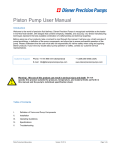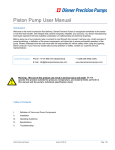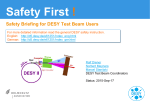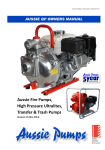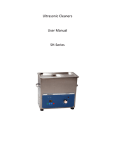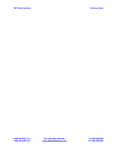Download Gear Pump User Manual - Diener Precision Pumps
Transcript
Gear Pump User Manual Introduction Welcome to the world of precision fluid delivery. Diener Precision Pumps is recognized worldwide as the leader in low-flow fluid transfer, with designs that combine simplicity, reliability, and accuracy. Our Swiss manufacturing techniques represent the best available combination of craftsmanship and technical expertise. Before using one of our products, take a moment to read through this manual. It will give you a brief overview of pump terminology, a definition of the pump components, and some tips to ensure successful operation of the pump. Please understand that the user must take full responsibility for his/her safety when using and applying Diener products. If you have any doubts about pump operation or safety, contact our customer service representatives. Customer Support: Phone: +41 44 866 7272 (Switzerland) +1 (209) 365-0405 (USA) E-mail: [email protected] www.dienerprecisionpumps.com Warning! Mis-use of this product can result in serious injury and death. Do not operate this product outside the pressure, temperature, and material limits set forth in this manual and the pump’s individual specification sheet. Table of Contents I. Definition of Terms and Pump Components II. Installation III. Operating Guidelines IV. Specifications V. Troubleshooting Gear Pump User Manual.docx Version: 21.01.14 Page: 1 (5) I. Definition of Terms and Pump Components Fluid Terms Viscosity the relative thickness of the fluid (higher viscosity = thicker fluid) Differential Pressure the relative difference between the outlet and inlet of the pump (the pressure “boost” provided by the pump) Static Case Pressure the pressure inside the pump when the pump is turned off Flow-rate the flow through the pump, usually expressed in milliliters/minute Fluid Temperature the temperature of the fluid in the pump Ambient Air Temperature the temperature of the environment outside the pump Mixed Phase the fluid contains a combination of gas and liquid Pump Terms Decoupling the condition when the driving and driven magnets disengage Cavitation vapor bubbles that form when the pressure falls below the vapor pressure of the fluid Self-priming a pump’s ability to prime itself Dry-running the period of time during which a pump can run dry without damage Starved the pump inlet is “starved” for fluid, usually due to an inlet restriction or no priming flow Duty Cycle the amount of time a pump a pump is turned “on” Gear Pump User Manual.docx Version: 21.01.14 Page: 2 (5) II. Installation 1. 2. 3. Handle the pump carefully. Hard impacts or rough handling can damage the magnetic coupling. Particulates in the fluid can harm the pump. We recommend that the fluid be filtered using a 40-micron (or smaller) filter mesh. For pumps fitted with tapered (NPT) port threads, use a suitable liquid thread sealer or Teflon tape. Support the pump head before tightening the fittings. Apply Teflon tape to fittings 4. 5. Remove the pump from the motor prior to tightening fittings Whenever possible, inject a small amount of fluid into the pump inlet prior to starting the pump. This helps the pump self-prime, and also prevents the loud squeaking that can occur if the gears are completely dry. The flow direction (inlet-to-outlet) is indicated by an arrow marked on the end of the pump. If your pump is equipped with an optional pressure relief valve, close the valve prior to startup. This is done by turning the adjustment screw completely clockwise. Warning: stop turning the screw when it’s snug—over-tightening may damage the valve seat. Internal pressure-relief valve: turn clockwise to close, counter-clockwise to open. 6. All electrical connections should be carried out by individuals qualified according to local electrical installation regulations. The electrical supply should match the motor nameplate values; all power should be turned off prior to making the connection. For motors supplied with separate speed control and tachometer leads, please follow the color coding information. Failure to do so may result in permanent motor damage and/or fire. Gear Pump User Manual.docx Version: 21.01.14 Page: 3 (5) III. Operating Guidelines When starting the pump, allow it to run for a brief period to remove all air in the lines. The inlet/outlet lines should be checked for restrictions. Excessive restrictions may cause the pump pressure to increase beyond the torque transmission of the magnetic coupling, resulting in decoupling. Removing the restrictions will help alleviate this problem. If decoupling occurs, stop the motor, remove the restriction and restart the motor. In general, the magnets will not re-couple unless the motor first comes to a complete stop. For pumps attached to DC motors, the flow and pressure can be adjusted by varying the motor speed. The pressure relief valve can also be used as a flow control, but is not as accurate as motor speed control. When using the relief valve as a flow control, slowly back out the adjustment screw until reaching the desired flow (turning it counter-clockwise). The noise level of the pump will depend on the motor type, the inlet/outlet pressure, and the motor speed. In general, the higher the pressures and speeds, the noisier the pump. Using a completely “closed” motor can help to minimize the motor noise. Other guidelines to follow include: Temperature: Do not allow fluid to freeze in the pump: the expansion can cause structural and seal damage. Pressure: Do not over-pressurize the pump (refer to the upper limits provided in the specification sheet). Failure to do so may damage the pump and cause serious injury. Chemical Attack: Expose the pump only to chemicals that are known to be compatible with the wetted materials in the pump (refer to specification sheet for a wetted materials list). Use protective clothing whenever handling dangerous fluids and follow the recommendations in the fluid’s material safety data sheet (MSDS). Immersion: Do not immerse the pumps in water, and under no circumstances should the motor be exposed to water (could result in injury or death). IV. Specifications Please refer to the individual pump data sheet for technical and dimensional specifications. Gear Pump User Manual.docx Version: 21.01.14 Page: 4 (5) V. Troubleshooting Problem Possible Cause Solution Pump does not pump No power Interference between driving magnet and pump Check inlet power Remove the screws that affix the pump to the motor. Briefly turn on the motor: if it spins, check the magnet cup for evidence of rubbing. Contact the factory for further instructions. Ensure that relief valve screw is closed (full clockwise rotation) prior to startup. Remove/inspect filter and replace filter element if required. Remove/inspect filter and replace filter element if required. Pressure relief valve not closed Blocked system filter Inlet/outlet tube size is too small Motor may be running in reverse Check the motor polarity (correct rotation is clockwise when looking at the motor shaft) Fluid viscosity is too high Verify that fluid viscosity is within limits in pump data sheet Pump makes a loud screeching noise at startup Pump is running dry Inject a small amount of fluid in the pump inlet and restart Pump decouples at startup Solids are stuck in the gears. Inlet/outlet lines are restricted. Fluid viscosity is too high Rinse the pump to remove solids, clean the lines and reservoir Remove the restriction, and/or open restrictive valves Reduce the motor speed Pump decouples at high temperature Thermal expansion of the gears cause binding in the pump. Lower the fluid temperature to within the limits specified by the factory Air bubbles in the line Leak on the inlet side of the pump Pump is cavitating on the inlet Reattach fittings using thread sealer or Teflon tape Slow the motor speed and/or remove the restriction on the inlet Pump is extremely noisy Interference in magnetic coupling Cavitation and/or high differential pressure Gear Pump User Manual.docx Version: 21.01.14 Remove the pump from the motor assembly and check for interference (contact factory for further assistance) Remove the restriction, and/or open restrictive valves Page: 5 (5)





